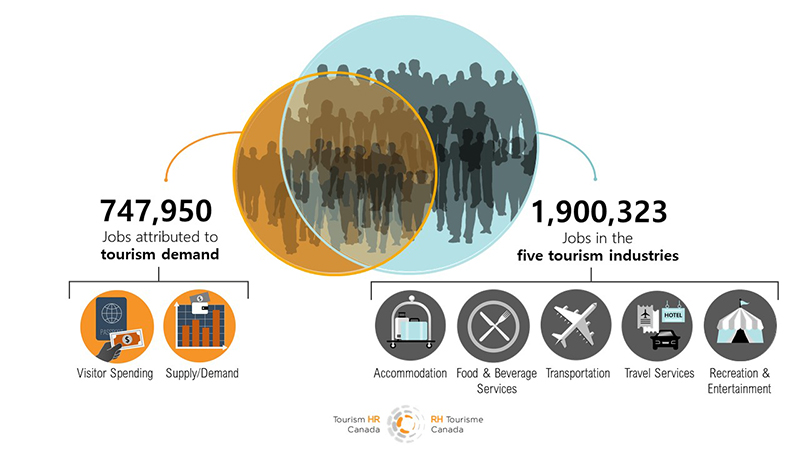Tourism jobs are defined by two numbers and both are from Statistics Canada—so why the two numbers and how is there a difference of over a million jobs?
The first number, 747,950, is based on tourism demand; in other words, it’s based on visitor spending. This number comes from the National Tourism Indicators (NTI), which covers the supply of tourism commodities (a tangible good or service, such as transportation, that can be bought and sold) and the demand for those commodities from foreign and domestic tourists. The NTI measures employment and GDP generated from visitor spending, and was developed to update the Canadian Tourism Satellite Account on a quarterly basis. This includes visitor spending on activities that are not limited to tourism businesses, such as money spent by visitors at gas stations or in retail stores. This number is a good measure of the impact of tourists on employment in the Canadian economy and is used to help determine, for example, whether marketing strategies are effective.
However, most tourism industries also provide goods and services to people who are not tourists. Restaurants and recreation venues such as golf courses and ski hills are part of the tourism sector because about 20% of demand for their products and services comes from visitor spending. Without tourists, these industries would suffer a significant hit to their bottom line. To measure overall employment in tourism industries, we need data that accounts for this.
The second jobs number, 1.9 million, is data from the Tourism Human Resource Module from Statistics Canada, an extension of the Tourism Satellite Account. This includes comprehensive data on the tourism workforce, with information on jobs, hours, earnings, occupations, worker demographics, and more. The information is defined by the five tourism industries: accommodation, food and beverage services, recreation and entertainment, transportation, and travel services.
TL;DR: 1.9 million is the number of jobs in tourism industries, whereas 747,950 is the number of jobs that exist due to visitor spending in all industries.
We focus on the 1.9 million number when concerned with workforce issues because:
- it’s an indication of the overall health or capacity of the sector and its ability to serve tourists (and Canadians);
- businesses manage and invest in their workers to serve both visitors and locals (i.e., they treat all workers the same); and
- as tourism recovers and the workforce restarts, this number will be very important, especially with the focus on hyper-local and local markets.
Check out this article to get a more detailed understanding of the three datasets— Census, Tourism Human Resource Module, and Labour Force Survey—that define tourism jobs and employees: Numbers Game: Defining Tourism Employment Stats.


